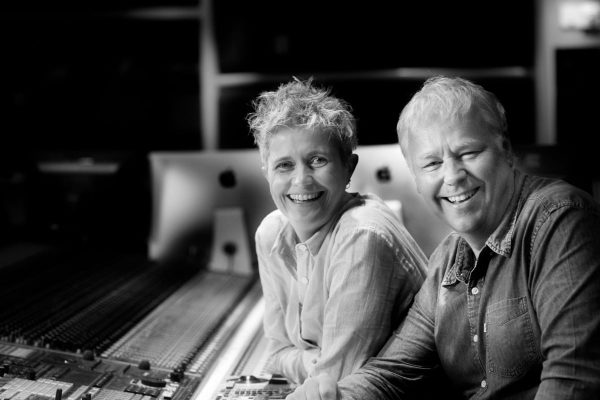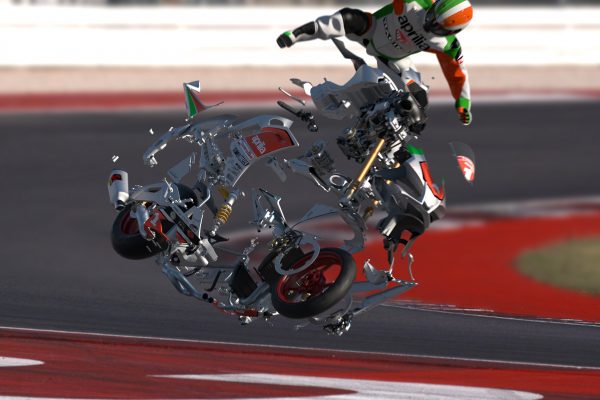By: Jen Temm
A pathway for emerging filmmakers and a playground for the established, the music video genre has slumped as an earner since its heyday through the ’80s and ’90s. It still offers experience and great career potential – but it helps if your video goes viral. There’s few greater examples than Natasha Pincus and Darcy Prendergast, the respective directors behind Gotye’s phenomenally successful Somebody That I Used To Know and Easy Way Out videos. They spoke to Video&Filmmaker about their painstaking and intense productions.
SOME VIDEO THAT WE USED TO KNOW
You think you get it bad with earworms? Imagine listening to Somebody That I Used To Know thousands of times. “You never get rid of it, it’s with you forever,” says Natasha Pincus, director, producer and editor of the famous body paint video for Gotye’s massive hit single. “I’d heard the song maybe two or three thousand times by the time I’d finished the video – and then it goes and becomes a worldwide hit and everywhere I go, it’s playing again!”
Not that she’s complaining – or about hallucinating painted triangles for days. When we spoke her first feature script Fell was on its last day of a 12-week shoot around Warburton in Victoria and another, Middle of the Air, had just been optioned by Goalpost Pictures in Sydney.
But <Somebody> is undoubtedly one of her most intensely challenging projects: months of pre-production, a two-day setup, 26 hours straight filming, and three weeks of non-stop editing. The video was a collaborative effort with cinematographer Warwick Field, Melbourne scenic artist Howard Clark, Adelaide body painter Emma Hack, performers Wally ‘Gotye’ De Backer and Kimbra and a small team of assistants, but the initial idea came from repeated listening.
“Listening to that song it was pretty clear to me that it’s about the end of a relationship and so that was always going to be the challenge, to find the right visual representation for that – and you can dramatise that using body paint and art and that idea came pretty quickly,” Pincus explains.
“I worked around the premise of being painted and de-painted as the formation of the relationship and then the separation of the two people so then the choice was, what’s that painting going to look like, rather than the device of it.”
THE SCIENCE OF ART
De Backer wholeheartedly endorsed the idea and offered his father Frank De Backer’s original painting as the basis for the artwork (Frank also designed the cover of the album Making Mirrors). The two spent weeks manipulating the piece – the younger De Backer proved a whizz at Photoshop – to achieve the best effect by positioning the colours to reflect the emotions of the characters. Then it was up to Pincus and DOP Warwick Field to plan every shot and every still frame so the filming days could be devoted to working with De Backer and Kimbra on their performances.
“There was a lot of practical engineering to it, deconstructing the song and trying to figure out where its turns are, where the gear changes are, and trying to find visual ways of emulating that,” Pincus says. “You have to break it down into mini plot points and turning points so that you keep the viewer engaged and intrigued the whole way through.
“We had the idea of the painting but you have to reverse engineer that into a back story and progress it forward as well, and see where it ultimately concludes. Each of those things are broken down into turning points that match sympathetically with the song so it’s like a screenwriting approach, and you have to keep working it into the concept: what are those key changes going to look like, how many frames, how many photos, how detailed is the artwork, how big is the canvas, the choreography of the movement.
“That’s the hard slog of the craft, and the art of it. To me it can’t be a trick, it can’t just be a gimmick. It has to be human, it has to be worthwhile emotionally.”
SINGERS, NOT ACTORS
De Backer and Kimbra rehearsed extensively before the shoot with the lyrics reduced down to lines and played out as dialogue between the two characters, with each tiny motion and look carefully choreographed to ensure every word was invested with meaning.
“I’m a massive believer in rehearsal but it’s not often practiced in music video culture for some reason, which is a problem,” Pincus says. “They’re singers, they’re not actors so I’m really bringing a lot of theatre training and ideology into a music video environment. Wally and I had a lot of rehearsals in my apartment and we’d nut out the lines like they were dialogue, and got him really comfortable with the camera and with Kimbra and the nudity. So there’s obviously immediacy and stress that’s elevated with the shoot but there were no surprises, we were pretty prepared.”
The shoot was incredibly arduous. A day and night setting up the equipment – a day for De Backer to do his ‘nude’ performance with the background mural being painted and capturing all the associated stop motion; and then day three: 26-hours non-stop to film the performances and apply the body paint, which took about seven hours each. And not a cup of coffee to be seen. Body painter Emma Hack advised against any kind of stimulants that might cause De Backer and Kimbra to tremble so the team had to rely on soothing music, massages and sheer determination to make it through the night.
“When I realised we were headed towards an all-night shoot, it wasn’t that different to being a coach at half-time at a grand final,” Pincus recalls, laughing. “I got everyone into the room and said look, this is going to hurt, the next 12 hours are going to be very uncomfortable but then we get to keep it forever. And it was such a small shoot and such a collaborative base, it felt like we were doing a sleepover – although at one point I did start hallucinating (those triangles) and Warwick fell asleep at the camera once.”
MILKING THE EDIT
Using a Canon 5D to capture both the live action and the stop motion stills, Pincus and Field employed a split screen with the stop motion on the right and the live action on the left to ensure the result would look perfectly seamless. The video was shot out of order because of the timings of the various paintings and reveals, and the desire for options in the edit meant shooting some 5000 stills and multiple versions of every part of the song. De Backer’s “Somebody” plea at the end was shot about 50 times to capture every possible emotion.
“It made the editing hard but, you know, editing is always hard,” Pincus says. “In this case it was about crafting a character arc for Wally’s character predominantly but also for Kimbra’s character. Wally could come across as a bit cold if you didn’t edit him correctly, the audience might resist him if he wasn’t vulnerable enough at the beginning and all those little moments – when he’s looking away, when he’s looking down – they’re all very much there on purpose to tell the audience when they should feel sorry for him and when they shouldn’t. The edit really milks that and measures it out.”
The on-camera chemistry between the two was the first hint the clip was going to be special, she says. “When I first had the idea they hadn’t chosen the other singer yet and it was just Wally – and then I met Kimbra and it was like, hey, I think we’re onto something.
“I was looking at a lot of the science and the intellectual quality and then realised it was going to be so amazing to watch these two people who are so beautiful in their spirit as well as their physicality. I realised the broader appeal rather than just my little art.”
HIGHEST FORM OF FLATTERY
Pincus’s “little art” has since been view more than 450 million times on YouTube and spawned covers and parodies from all around the world – including her personal favourite, a sendup on Saturday Night Live. The song topped the Australian, US and UK charts as well as 23 other national charts, while the video picked up an ARIA for best music video of the year; was voted No. 1 in the annual Rage Fifty Countdown; and was nominated for Video of the Year and Best Editing in the 2012 MTV Video Music Awards.
And while the phenomenal success of Somebody has boosted her profile on a massive scale, prompting lucrative career offers in major brand commercials and music videos for the biggest names in the business, Pincus sees music videos as simply another string to her impressive bow.
“I love making music videos and I will always make them but they’re not my main game. My major practice is as a screenwriter,” she says.
“I was offered a lot of stuff, especially in the US, and it was tempting at first because I’ve done this for so long without any financial reward but I just could not bring myself to do it. Fortunately for me at the same time a script I’d written (Clive) got onto the Blacklist (an annual list of top scripts circulating Hollywood) and the combination of that and the Gotye video helped my feature film career take off in a proper way.”
The 35-year-old first started writing and filmmaking as a teenager, producing a couple of shorts before taking on a law career. She graduated with first class honours in Law and Science in 2002 and practiced then taught law for several years before focusing on screen writing and directing. Her first foray into music videos was in 2007, directing the stark and powerful video for Paul Kelly’s award winning God Told Me To, a song based on a fictional character on trial for murder.
“It reinforces a few things for me, that particular video. It doesn’t rely on visual effects and trickery and manic cutting. You must have faith in your audience, that the age-old tricks of mystery and intrigue that Hitchcock could manipulate at will still apply,” she says.
“People essentially still want to see a story, they want to be engaged and they don’t need the flashing lights. People are sophisticated – they haven’t lost their taste and they haven’t lost their ability to think and dream. They’re not always allowed to do it because of the filmmaking styles of the day but I think some things just stand the test of time.”






